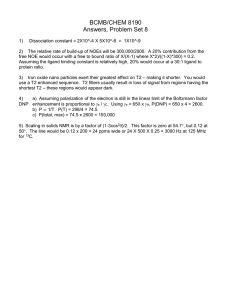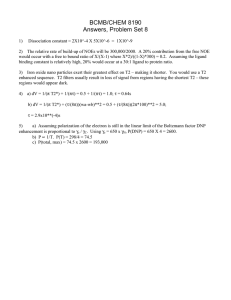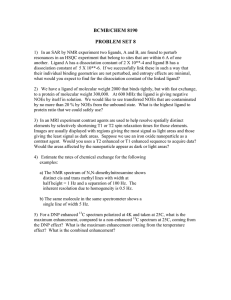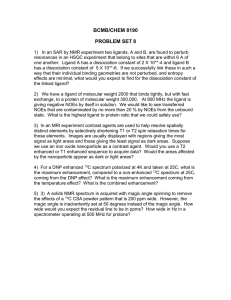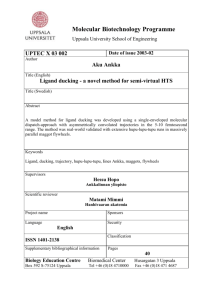Synthesizing a Novel Chelating Model
advertisement
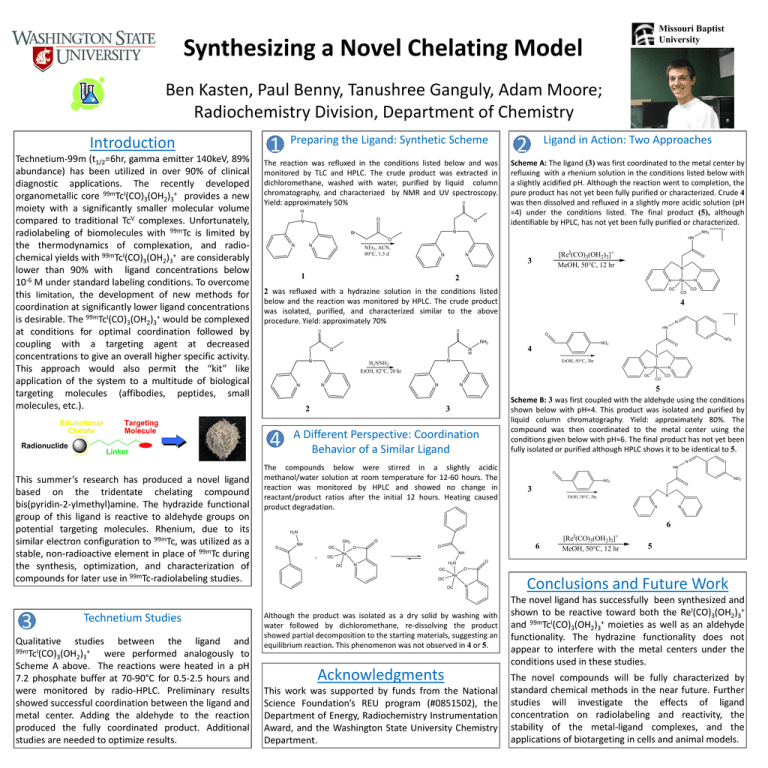
Missouri Baptist University Synthesizing a Novel Chelating Model Ben Kasten, Paul Benny, Tanushree Ganguly, Adam Moore; Radiochemistry Division, Department of Chemistry Introduction Technetium-99m (t1/2=6hr, gamma emitter 140keV, 89% abundance) has been utilized in over 90% of clinical diagnostic applications. The recently developed organometallic core 99mTcI(CO)3(OH2)3+ provides a new moiety with a significantly smaller molecular volume compared to traditional TcV complexes. Unfortunately, radiolabeling of biomolecules with 99mTc is limited by the thermodynamics of complexation, and radiochemical yields with 99mTcI(CO)3(OH2)3+ are considerably lower than 90% with ligand concentrations below 10-6 M under standard labeling conditions. To overcome this limitation, the development of new methods for coordination at significantly lower ligand concentrations is desirable. The 99mTcI(CO)3(OH2)3+ would be complexed at conditions for optimal coordination followed by coupling with a targeting agent at decreased concentrations to give an overall higher specific activity. This approach would also permit the “kit” like application of the system to a multitude of biological targeting molecules (affibodies, peptides, small molecules, etc.). 1 The reaction was refluxed in the conditions listed below and was monitored by TLC and HPLC. The crude product was extracted in dichloromethane, washed with water, purified by liquid column chromatography, and characterized by NMR and UV spectroscopy. Yield: approximately 50% 3 Technetium Studies Qualitative studies between the ligand and 99mTcI(CO) (OH ) + were performed analogously to 3 2 3 Scheme A above. The reactions were heated in a pH 7.2 phosphate buffer at 70-90°C for 0.5-2.5 hours and were monitored by radio-HPLC. Preliminary results showed successful coordination between the ligand and metal center. Adding the aldehyde to the reaction produced the fully coordinated product. Additional studies are needed to optimize results. Ligand in Action: Two Approaches 2 Scheme A: The ligand (3) was first coordinated to the metal center by refluxing with a rhenium solution in the conditions listed below with a slightly acidified pH. Although the reaction went to completion, the pure product has not yet been fully purified or characterized. Crude 4 was then dissolved and refluxed in a slightly more acidic solution (pH ≈4) under the conditions listed. The final product (5), although identifiable by HPLC, has not yet been fully purified or characterized. 3 1 2 2 was refluxed with a hydrazine solution in the conditions listed below and the reaction was monitored by HPLC. The crude product was isolated, purified, and characterized similar to the above procedure. Yield: approximately 70% 4 4 2 4 This summer’s research has produced a novel ligand based on the tridentate chelating compound bis(pyridin-2-ylmethyl)amine. The hydrazide functional group of this ligand is reactive to aldehyde groups on potential targeting molecules. Rhenium, due to its similar electron configuration to 99mTc, was utilized as a stable, non-radioactive element in place of 99mTc during the synthesis, optimization, and characterization of compounds for later use in 99mTc-radiolabeling studies. Preparing the Ligand: Synthetic Scheme 3 A Different Perspective: Coordination Behavior of a Similar Ligand The compounds below were stirred in a slightly acidic methanol/water solution at room temperature for 12-60 hours. The reaction was monitored by HPLC and showed no change in reactant/product ratios after the initial 12 hours. Heating caused product degradation. 5 Scheme B: 3 was first coupled with the aldehyde using the conditions shown below with pH≈4. This product was isolated and purified by liquid column chromatography. Yield: approximately 80%. The compound was then coordinated to the metal center using the conditions given below with pH≈6. The final product has not yet been fully isolated or purified although HPLC shows it to be identical to 5. 3 6 6 5 Conclusions and Future Work Although the product was isolated as a dry solid by washing with water followed by dichloromethane, re-dissolving the product showed partial decomposition to the starting materials, suggesting an equilibrium reaction. This phenomenon was not observed in 4 or 5. Acknowledgments This work was supported by funds from the National Science Foundation’s REU program (#0851502), the Department of Energy, Radiochemistry Instrumentation Award, and the Washington State University Chemistry Department. The novel ligand has successfully been synthesized and shown to be reactive toward both the ReI(CO)3(OH2)3+ and 99mTcI(CO)3(OH2)3+ moieties as well as an aldehyde functionality. The hydrazine functionality does not appear to interfere with the metal centers under the conditions used in these studies. The novel compounds will be fully characterized by standard chemical methods in the near future. Further studies will investigate the effects of ligand concentration on radiolabeling and reactivity, the stability of the metal-ligand complexes, and the applications of biotargeting in cells and animal models.
